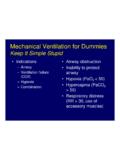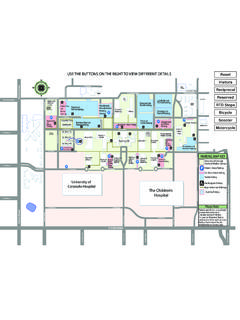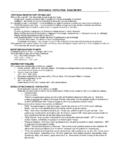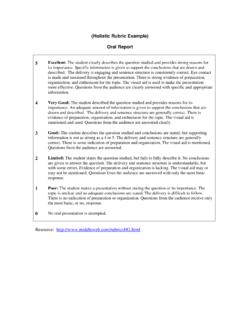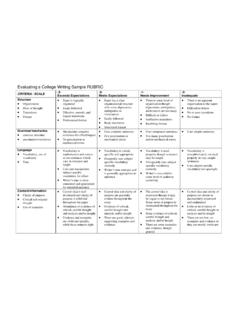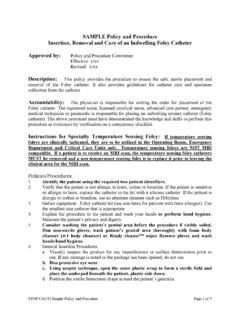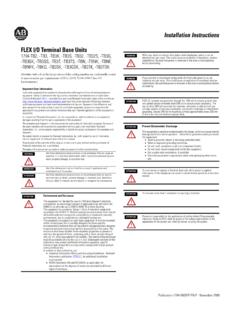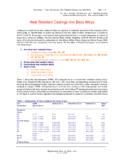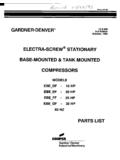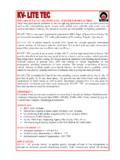Transcription of Evaluation of Acid-Base Disorders - Denver, Colorado
1 Evaluation of Acid-Base Disorders What you need: (1) arterial blood gas and serum electrolytes drawn at the same point in time; (2) an understanding of the patient's history; (3) a basic understanding of physiology and biochemistry; (4) common sense. Normal arterial pH range: ( ). Normal arterial PaCO2 range: 38 42 mmHg (40 mmHg). Normal serum CO2 range: 22 26 mEq/L (24 mEq/L). A note about terminology: the serum (venous) value that is measured in the chemistry lab is the total CO2, it represents the bicarbonate moiety (HCO3) that is buffered by organic acids. Remember, pH = - log [H+] = + log ([HCO3] / [ * PaCO2] ) (HCO3/PaCO2). RESPIRATORY ACIDOSIS. Characteristics: elevated PaCO2, decreased extracellular pH. (CO2 production at tissue level exceeds CO2 elimination by lungs).
2 Causes: CNS depression (sedatives, CNS disease, obesity-hypoventilation syndrome); pleural disease (large pneumothoraces and pleural effusions); lung disease (COPD, ARDS); musculoskeletal and neuromuscular Disorders (kyphoscoliosis, Guillain-Barre syndrome, myasthenia gravis, polymyositis). Compensation: ACUTE: pH drops by units and HCO3 increases by 1 mEq/L per 10 mmHg increase in PaCO2 (up to a PaCO2 of 70). CHRONIC: pH drops by units and HCO3 increases by 3-4 mEq/L per 10 mmHg increase in PaCO2 (up to a PaCO2 of 70). Renal compensation (HCO3 retention) generally at its maximum by 4 days, is never complete ( , pH is never normalized). Consider: In general, if the HCO3 is above 30, look for a second process (chronic respiratory acidosis, concomitant metabolic alkalosis).
3 RESPIRATORY ALKALOSIS. Characteristics: decreased PaCO2, increased extracellular pH. (implies that the increase in alveolar ventilation and consequent decrease in PaCO2 are not compensatory responses to hypoxemia). Evaluation of Acid-Base Disorders Page 2 of 4. Causes: catastrophic CNS disorder (ICH); drugs (salicylates, progesterone); pregnancy (generally during 3rd trimester); decreased lung compliance (such as interstitial fibrosis) leading to hyperventilation and respiratory alkalosis even in the absence of hypoxemia; anxiety; cirrhosis; sepsis. Compensation: ACUTE: pH increases by units and HCO3 decreases by 2 mEq/L per 10 mmHg decrease in PaCO2. (down to a PaCO2 of 20). CHRONIC: pH increases by units and HCO3 decreases by 5 mEq/L per 10 mmHg decrease in PaCO2.
4 (down to a PaCO2 of 20). Renal compensation via suppression of renal acid secretion and subsequent consumption and decrease in serum HCO3. In contrast to respiratory acidosis, however, the compensation for a long-standing process may eventually become complete ( , pH normal). Consider: If the HCO3 has dropped by more than 2-4, consider a superimposed metabolic acidosis, ASA, sepsis, or chronic hyperventilation. METABOLIC ACIDOSIS. Characteristics: decreased serum HCO3, decreased extracellular pH. Causes: divide into INCREASED versus NORMAL ANION GAP causes. Anion Gap (AG) = Na [Cl + HCO3] = 12 (10-14). {best normal' AG is from recent electrolytes measured when the patient had a normal Acid-Base balance}. Represents difference between unmeasured anions (proteins, phosphates, sulfates, organic acids = 23.)
5 MEq/L) and unmeasured cations (K, Ca, Mg = 11 mEq/L). Affected by albumin, which is most abundant unmeasured anion. If hypoalbuminemic, the normal' AG is lower (by mEq/L for every 1 gm/dL the albumin is decreased from ). If pH is > , more negative charges are exposed on albumin therefore the normal' AG is increased. INCREASED AG: can divide into 4 main categories: renal failure; ketoacidosis (diabetes, EtOH); drugs or poisons (MeOH, ASA, paraldehyde, ethylene glycol); lactic acidosis ( hypoxemia); sepsis. Pneumonic MUDPILES: Methanol, Uremia, Diabetic/alcoholic ketoacidosis, Paraldehyde, Isoniazid/Iron, Lactic acidosis/ketoacidosis, Ethylene glycol, Salicylates NORMAL AG (hyperchloremic): GI loss of HCO3; renal tubular acidosis, carbonic anhydrase inhibitor use ( , acetazolamide); renal compensation for respiratory alkalosis; drugs (cyclosporine, amphoB, cholesyramine); VIP-producing tumors; ureteral diversions.
6 Pneumonic HARDUP: Hyperventilation, Acids (carbonic anhydrase inhibitors, Addison's disease, TPN), RTA, Diarrhea, Ureterosigmoidostomy (and ileal diversions), Pancreatic fistula or drainage. Compensation: in a maximally-compensated metabolic acidosis (which takes about 12-24 hours), Winter's formula applies: Expected PaCO2 = ( x serum HCO3)+(8 2); a shortcut to this formula is that the Expected PaCO2 is approximately equal to the last two digits of the pH 2. Using the rule of 15 you can predict the PaCO2 and pH from the serum HCO3: measured HCO3. + 15 = predicted PaCO2 and the last two digits of the pH. As the HCO3 drops below 10 and approaches 5. mEq/L, the PaCO2 should go to 15. If the PaCO2 is lower than expected, there is also a concomitant primary respiratory alkalosis (this is NOT just better respiratory compensation).
7 If the PaCO2 is higher than expected, then there is a concomitant primary respiratory acidosis. Also: Check the / : This is the AG/ HCO3 [ , (change in anion gap from 12)/(change in bicarbonate from 24)] and is based upon the concept that the increase in the anion gap should equal the fall in the bicarbonate and the / ratio should therefore equal Another way of expressing this is called the bicarbonate gap, which is ( AG - HCO3), and should equal zero. In other words, the AG plus the measured HCO3 should equal a normal HCO3 of 24. For an uncomplicated high AG metabolic acidosis, the / ratio should be between and The disparity from is related to volume of distribution of different anions ( , lactate remains primarily extracellular versus hydrogen ions which move intracellularly) and degree of buffering in cells and bone versus by HCO3 in the extracellular compartment.
8 If the AG is smaller than the HCO3 by at least 4 (HCO3 falls by more than AG; / less than ; negative bicarbonate gap), then there is a superimposed process which is causing a further fall in the HCO3 (non-gap metabolic acidosis and/or bicarbonate excretion as compensation for respiratory alkalosis). If the AG is greater than the HCO3 by at least 4 (HCO3 falls by less than the AG; / greater than ; positive bicarbonate gap), then there is a superimposed metabolic alkalosis and/or bicarbonate retention as compensation for respiratory acidosis. Evaluation of Acid-Base Disorders Page 3 of 4. Given the variations in baseline normal' AG, baseline HCO3, and electrolyte values, there is no absolute cut-off for these values. The more abnormal the / (bicarbonate gap), the more likely it reflects a concomitant Acid-Base disorder.
9 METABOLIC ALKALOSIS. Characteristics: increased serum HCO3, increased extracellular pH (may see mild increase in PaCO2 as compensation). Causes: generally either volume contraction (volume loss: GI tract, kidneys, skin, respiratory system, third-spaced fluid, bleeding) or hypokalemia. Also, excessive glucocorticoids or mineralocorticoids, Bartter's syndrome, exogenous alkalai ingestion. Two types: Chloride responsive and Chloride resistant. Chloride responsive: vomiting, diuretics, NG suction, diarrhea, villous adenoma. Spot urine Cl should be less than 10 (except with diuretic use) since the kidney should be conserving Cl. Treatment with should fix the disturbance. Chloride resistant: distal exchange site stimulation by aldosterone resulting in increased H+ and K excretion in exchange for resorption of Na+ as NaHCO3.
10 +. Compensation: is highly variable, and in some cases there may be no or minimal compensation. In chronic metabolic alkalosis, the PaCO2 should increase by roughly 5 mmHg for every 10 mEq/L increase in serum HCO3. SIX-STEP APPROACH TO Acid-Base ANALYSIS. 1. Acidemic or Alkalemic? pH < or > on ABG? 2. Is the overriding disturbance respiratory or metabolic? Respiratory acidosis: PaCO2 > 40 mmHg Metabolic acidosis: serum HCO3 < 24 mEq/L. 3. If a respiratory disturbance is present, is it acute or chronic? 4. If metabolic acidosis is present, is there an increased anion gap? - can have an anion gap acidosis even with a normal anion gap if hypoalbuminemic (decrease in unmeasured anions). - anion gap may be increased due to metabolic alkalosis, if pH > more negative charges are exposed on the surface of albumin therefore there is an increase in unmeasured anions.
